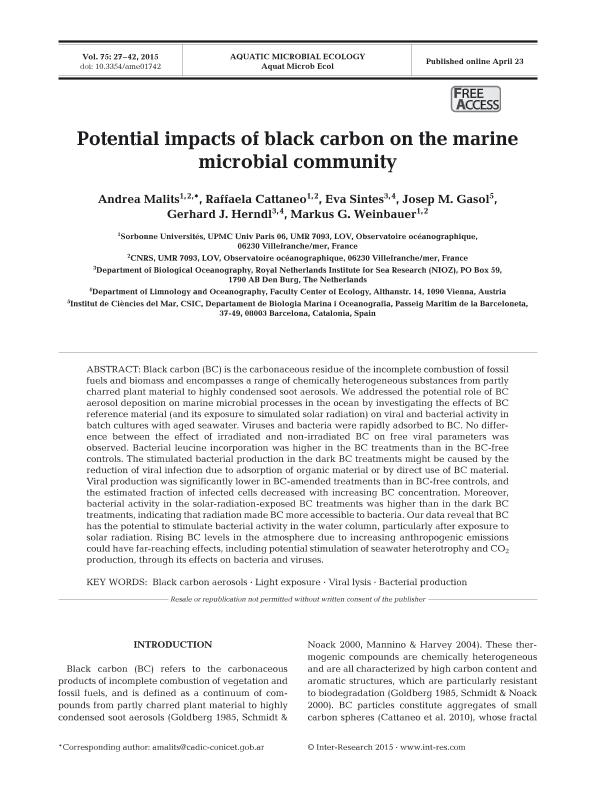Mostrar el registro sencillo del ítem
dc.contributor.author
Malits, Andrea

dc.contributor.author
Cattaneo, Raffaela
dc.contributor.author
Sintes, Eva
dc.contributor.author
Gasol, Josep M.
dc.contributor.author
Herndl, Gerhard J.
dc.contributor.author
Weinbauer, Markus G.
dc.date.available
2016-12-02T20:40:15Z
dc.date.issued
2015-04
dc.identifier.citation
Malits, Andrea; Cattaneo, Raffaela; Sintes, Eva ; Gasol, Josep M. ; Herndl, Gerhard J. ; et al.; Potential impacts of black carbon on the marine microbial community; Inter-research; Aquatic Microbial Ecology; 75; 1; 4-2015; 27-42
dc.identifier.issn
0948-3055
dc.identifier.uri
http://hdl.handle.net/11336/8731
dc.description.abstract
Black Carbon (BC) is the carbonaceous residue of the incomplete combustion of fossil fuels and biomass and encompasses a range of chemically heterogeneous substances from partly charred plant material to highly condensed soot aerosols. We addressed the potential role of BC aerosol deposition on marine microbial processes in the ocean by investigating the effects of BC reference material (and its exposure to simulated solar radiation) on viral and bacterial activity in batch cultures with aged seawater. Viruses and bacteria were rapidly adsorbed to BC. No difference between the effect of irradiated and non-irradiated BC on free viral parameters were observed. Bacterial leucine incorporation was higher in the BC treatments than in the BC-free controls. The stimulated bacterial production in the dark BC treatments might be caused by the reduction of viral infection due to adsorption of organic material or by direct use of BC material. Viral production was significantly lower in BC-amended treatments than in BC-free controls and the estimated fraction of infected cells decreased with increasing BC concentration. Moreover, bacterial activity in the solar-radiation-exposed-BC treatments was higher than in the dark BC treatments, indicating that radiation made BC more accessible to bacteria. Our data reveal that BC has the potential to stimulate bacterial activity in the water column, particularly after exposure to solar radiation. Rising black carbon levels in the atmosphere due to increasing anthropogenic emissions could have far-reaching effects, including potential stimulation of seawater heterotrophy and CO2 production, through its effects on bacteria and viruses.
dc.format
application/pdf
dc.language.iso
eng
dc.publisher
Inter-research

dc.rights
info:eu-repo/semantics/openAccess
dc.rights.uri
https://creativecommons.org/licenses/by-nc-sa/2.5/ar/
dc.subject
Black Carbon Aerosols
dc.subject
Light Exposure
dc.subject
Viral Lysis
dc.subject
Bacterial Production
dc.subject.classification
Biología Marina, Limnología

dc.subject.classification
Ciencias Biológicas

dc.subject.classification
CIENCIAS NATURALES Y EXACTAS

dc.title
Potential impacts of black carbon on the marine microbial community
dc.type
info:eu-repo/semantics/article
dc.type
info:ar-repo/semantics/artículo
dc.type
info:eu-repo/semantics/publishedVersion
dc.date.updated
2016-12-01T19:55:21Z
dc.journal.volume
75
dc.journal.number
1
dc.journal.pagination
27-42
dc.journal.pais
Alemania

dc.journal.ciudad
Oldendorf/Luhe
dc.description.fil
Fil: Malits, Andrea. CNRS, Observatoire océanographique; Francia. Sorbonne Universités. UPMC Univ Paris. Observatoire océanographique; Francia
dc.description.fil
Fil: Cattaneo, Raffaela. Sorbonne Universités. UPMC Univ Paris. Observatoire océanographique; Francia. CNRS, Observatoire océanographique; Francia
dc.description.fil
Fil: Sintes, Eva. Netherland Institute For Sea Research; Países Bajos. Royal Netherlands Institute for Sea Research. Department of Biological Oceanography; Países Bajos
dc.description.fil
Fil: Gasol, Josep M.. Consejo Superior de Investigaciones Cientificas; España
dc.description.fil
Fil: Herndl, Gerhard J.. Netherland Institute For Sea Research; Países Bajos. Royal Netherlands Institute for Sea Research. Department of Biological Oceanography; Países Bajos
dc.description.fil
Fil: Weinbauer, Markus G.. Sorbonne Universités. UPMC Univ Paris. Observatoire océanographique; Francia. CNRS, Observatoire océanographique; Francia
dc.journal.title
Aquatic Microbial Ecology

dc.relation.alternativeid
info:eu-repo/semantics/altIdentifier/url/http://www.int-res.com/abstracts/ame/v75/n1/p27-42/
dc.relation.alternativeid
info:eu-repo/semantics/altIdentifier/doi/http:/dx.doi.org/10.3354/ame01742
Archivos asociados
